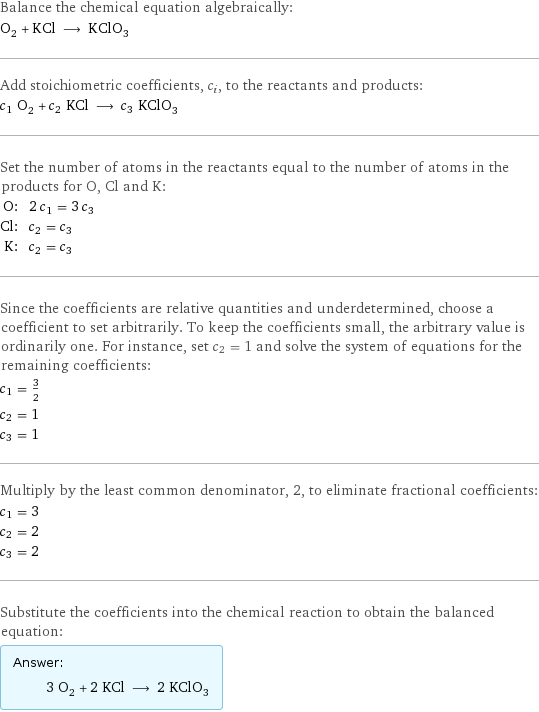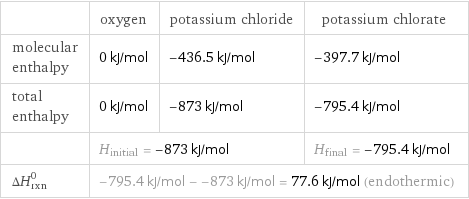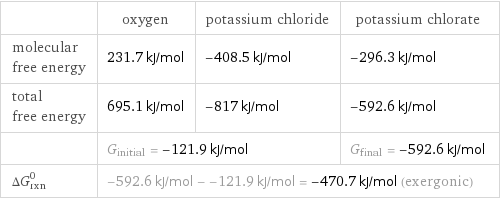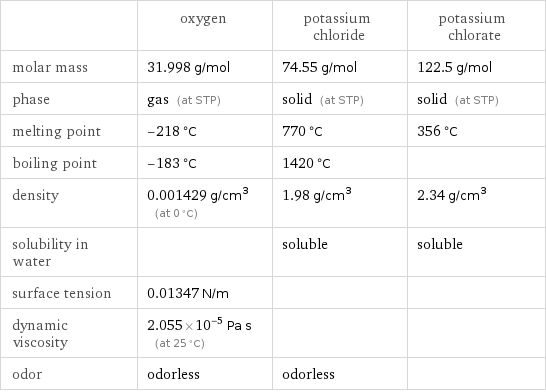Input interpretation

O_2 oxygen + KCl potassium chloride ⟶ KClO_3 potassium chlorate
Balanced equation

Balance the chemical equation algebraically: O_2 + KCl ⟶ KClO_3 Add stoichiometric coefficients, c_i, to the reactants and products: c_1 O_2 + c_2 KCl ⟶ c_3 KClO_3 Set the number of atoms in the reactants equal to the number of atoms in the products for O, Cl and K: O: | 2 c_1 = 3 c_3 Cl: | c_2 = c_3 K: | c_2 = c_3 Since the coefficients are relative quantities and underdetermined, choose a coefficient to set arbitrarily. To keep the coefficients small, the arbitrary value is ordinarily one. For instance, set c_2 = 1 and solve the system of equations for the remaining coefficients: c_1 = 3/2 c_2 = 1 c_3 = 1 Multiply by the least common denominator, 2, to eliminate fractional coefficients: c_1 = 3 c_2 = 2 c_3 = 2 Substitute the coefficients into the chemical reaction to obtain the balanced equation: Answer: | | 3 O_2 + 2 KCl ⟶ 2 KClO_3
Structures

+ ⟶
Names

oxygen + potassium chloride ⟶ potassium chlorate
Reaction thermodynamics
Enthalpy

| oxygen | potassium chloride | potassium chlorate molecular enthalpy | 0 kJ/mol | -436.5 kJ/mol | -397.7 kJ/mol total enthalpy | 0 kJ/mol | -873 kJ/mol | -795.4 kJ/mol | H_initial = -873 kJ/mol | | H_final = -795.4 kJ/mol ΔH_rxn^0 | -795.4 kJ/mol - -873 kJ/mol = 77.6 kJ/mol (endothermic) | |
Gibbs free energy

| oxygen | potassium chloride | potassium chlorate molecular free energy | 231.7 kJ/mol | -408.5 kJ/mol | -296.3 kJ/mol total free energy | 695.1 kJ/mol | -817 kJ/mol | -592.6 kJ/mol | G_initial = -121.9 kJ/mol | | G_final = -592.6 kJ/mol ΔG_rxn^0 | -592.6 kJ/mol - -121.9 kJ/mol = -470.7 kJ/mol (exergonic) | |
Entropy

| oxygen | potassium chloride | potassium chlorate molecular entropy | 205 J/(mol K) | 83 J/(mol K) | 143 J/(mol K) total entropy | 615 J/(mol K) | 166 J/(mol K) | 286 J/(mol K) | S_initial = 781 J/(mol K) | | S_final = 286 J/(mol K) ΔS_rxn^0 | 286 J/(mol K) - 781 J/(mol K) = -495 J/(mol K) (exoentropic) | |
Equilibrium constant
![Construct the equilibrium constant, K, expression for: O_2 + KCl ⟶ KClO_3 Plan: • Balance the chemical equation. • Determine the stoichiometric numbers. • Assemble the activity expression for each chemical species. • Use the activity expressions to build the equilibrium constant expression. Write the balanced chemical equation: 3 O_2 + 2 KCl ⟶ 2 KClO_3 Assign stoichiometric numbers, ν_i, using the stoichiometric coefficients, c_i, from the balanced chemical equation in the following manner: ν_i = -c_i for reactants and ν_i = c_i for products: chemical species | c_i | ν_i O_2 | 3 | -3 KCl | 2 | -2 KClO_3 | 2 | 2 Assemble the activity expressions accounting for the state of matter and ν_i: chemical species | c_i | ν_i | activity expression O_2 | 3 | -3 | ([O2])^(-3) KCl | 2 | -2 | ([KCl])^(-2) KClO_3 | 2 | 2 | ([KClO3])^2 The equilibrium constant symbol in the concentration basis is: K_c Mulitply the activity expressions to arrive at the K_c expression: Answer: | | K_c = ([O2])^(-3) ([KCl])^(-2) ([KClO3])^2 = ([KClO3])^2/(([O2])^3 ([KCl])^2)](../image_source/c387e89a63cbd229d89c27a350f5c25d.png)
Construct the equilibrium constant, K, expression for: O_2 + KCl ⟶ KClO_3 Plan: • Balance the chemical equation. • Determine the stoichiometric numbers. • Assemble the activity expression for each chemical species. • Use the activity expressions to build the equilibrium constant expression. Write the balanced chemical equation: 3 O_2 + 2 KCl ⟶ 2 KClO_3 Assign stoichiometric numbers, ν_i, using the stoichiometric coefficients, c_i, from the balanced chemical equation in the following manner: ν_i = -c_i for reactants and ν_i = c_i for products: chemical species | c_i | ν_i O_2 | 3 | -3 KCl | 2 | -2 KClO_3 | 2 | 2 Assemble the activity expressions accounting for the state of matter and ν_i: chemical species | c_i | ν_i | activity expression O_2 | 3 | -3 | ([O2])^(-3) KCl | 2 | -2 | ([KCl])^(-2) KClO_3 | 2 | 2 | ([KClO3])^2 The equilibrium constant symbol in the concentration basis is: K_c Mulitply the activity expressions to arrive at the K_c expression: Answer: | | K_c = ([O2])^(-3) ([KCl])^(-2) ([KClO3])^2 = ([KClO3])^2/(([O2])^3 ([KCl])^2)
Rate of reaction
![Construct the rate of reaction expression for: O_2 + KCl ⟶ KClO_3 Plan: • Balance the chemical equation. • Determine the stoichiometric numbers. • Assemble the rate term for each chemical species. • Write the rate of reaction expression. Write the balanced chemical equation: 3 O_2 + 2 KCl ⟶ 2 KClO_3 Assign stoichiometric numbers, ν_i, using the stoichiometric coefficients, c_i, from the balanced chemical equation in the following manner: ν_i = -c_i for reactants and ν_i = c_i for products: chemical species | c_i | ν_i O_2 | 3 | -3 KCl | 2 | -2 KClO_3 | 2 | 2 The rate term for each chemical species, B_i, is 1/ν_i(Δ[B_i])/(Δt) where [B_i] is the amount concentration and t is time: chemical species | c_i | ν_i | rate term O_2 | 3 | -3 | -1/3 (Δ[O2])/(Δt) KCl | 2 | -2 | -1/2 (Δ[KCl])/(Δt) KClO_3 | 2 | 2 | 1/2 (Δ[KClO3])/(Δt) (for infinitesimal rate of change, replace Δ with d) Set the rate terms equal to each other to arrive at the rate expression: Answer: | | rate = -1/3 (Δ[O2])/(Δt) = -1/2 (Δ[KCl])/(Δt) = 1/2 (Δ[KClO3])/(Δt) (assuming constant volume and no accumulation of intermediates or side products)](../image_source/fdf39cb28b00aaef1fcb6a96b6bdb6f4.png)
Construct the rate of reaction expression for: O_2 + KCl ⟶ KClO_3 Plan: • Balance the chemical equation. • Determine the stoichiometric numbers. • Assemble the rate term for each chemical species. • Write the rate of reaction expression. Write the balanced chemical equation: 3 O_2 + 2 KCl ⟶ 2 KClO_3 Assign stoichiometric numbers, ν_i, using the stoichiometric coefficients, c_i, from the balanced chemical equation in the following manner: ν_i = -c_i for reactants and ν_i = c_i for products: chemical species | c_i | ν_i O_2 | 3 | -3 KCl | 2 | -2 KClO_3 | 2 | 2 The rate term for each chemical species, B_i, is 1/ν_i(Δ[B_i])/(Δt) where [B_i] is the amount concentration and t is time: chemical species | c_i | ν_i | rate term O_2 | 3 | -3 | -1/3 (Δ[O2])/(Δt) KCl | 2 | -2 | -1/2 (Δ[KCl])/(Δt) KClO_3 | 2 | 2 | 1/2 (Δ[KClO3])/(Δt) (for infinitesimal rate of change, replace Δ with d) Set the rate terms equal to each other to arrive at the rate expression: Answer: | | rate = -1/3 (Δ[O2])/(Δt) = -1/2 (Δ[KCl])/(Δt) = 1/2 (Δ[KClO3])/(Δt) (assuming constant volume and no accumulation of intermediates or side products)
Chemical names and formulas

| oxygen | potassium chloride | potassium chlorate formula | O_2 | KCl | KClO_3 Hill formula | O_2 | ClK | ClKO_3 name | oxygen | potassium chloride | potassium chlorate IUPAC name | molecular oxygen | potassium chloride | potassium chlorate
Substance properties

| oxygen | potassium chloride | potassium chlorate molar mass | 31.998 g/mol | 74.55 g/mol | 122.5 g/mol phase | gas (at STP) | solid (at STP) | solid (at STP) melting point | -218 °C | 770 °C | 356 °C boiling point | -183 °C | 1420 °C | density | 0.001429 g/cm^3 (at 0 °C) | 1.98 g/cm^3 | 2.34 g/cm^3 solubility in water | | soluble | soluble surface tension | 0.01347 N/m | | dynamic viscosity | 2.055×10^-5 Pa s (at 25 °C) | | odor | odorless | odorless |
Units
